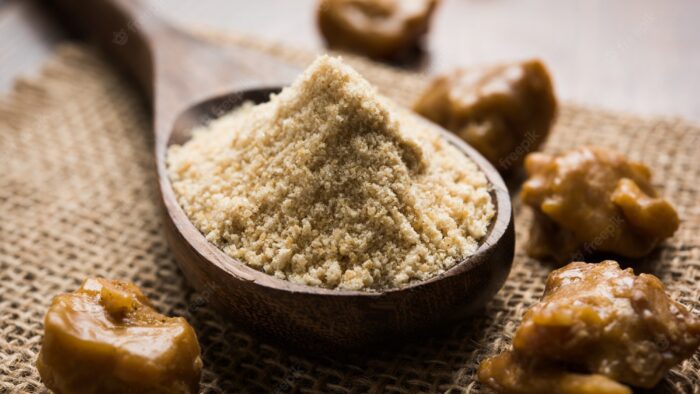Bhojanakutuhala, the ancient ayurvedic cookbook from the 17th century CE, classifies hingu in the primary blend of spices used for tempering oil (chownk) known as the sambhara/veshavara group. Combinations in this group can transform a bland meal into mouth-watering flavourful and memorable food.
One of the most famous members of the ferula group of the celery family, known botanically as Umbelliferae, is the ancient ayurvedic herb hingu, known as hing or asafoetida in English. Notice the unpleasant Latin term foetid in its name, telling you of its smelly, fetid pungent odour! Also known as devil's dung, hingu is the dried latex exuded from the rhizome or taproot of this tall perennial herb native to the deserts of Iran and mountains of Afghanistan, where substantial harvests are still grown.
Because it is a substance of satvika variety, hingu is used as an excellent replacement for onions and garlic,
which are considered tamasic
 The term hingu refers to its smell being perceived quickly, penetrating and pungent. It also has an interesting attribute of increasing its own intensity as it is exposed to air. This has given it the common name "stinking gum" by virtue of its richness in dimethyl trisulfide, an organo-sulphide. Sulfur is known to most people as the smell of rotten eggs.
The term hingu refers to its smell being perceived quickly, penetrating and pungent. It also has an interesting attribute of increasing its own intensity as it is exposed to air. This has given it the common name "stinking gum" by virtue of its richness in dimethyl trisulfide, an organo-sulphide. Sulfur is known to most people as the smell of rotten eggs.
Luckily, the odour dissipates upon cooking, delivering a smooth flavour reminiscent of leeks or others in the onion family. Because it is a substance of satvika variety, hingu is used as an excellent replacement for onions and garlic, which are considered tamasic.
Ayurveda characterizes hingu to be light to digest (laghu), sharp (teekshna), oily (snigdha) & pungent (katu) in taste. The drug is primarily utilized in ayurveda for increasing appetite (deepana), pain relief (vedana stapana) & digestive (pachana). Hingu works as a muscle relaxant, and is therefore beneficial in stomachache (anaha), bloating (adhmana), similarly in constipation (vibanda). Hingu is wonderful for the pacification of vata & kapha, but might worsen pitta at the doshic levels of function.
हिंगूष्णं पाचनं रुच्यं तीक्ष्णं वातबलासहृत् ।
शूलगुलमोदरानाहकृमिघ्नं पित्तवर्धनम् ।।
स्त्रीपुष्पजननं बल्यं मूर्च्छापस्मारहृत् परम् ||
Source: Bhavaprakasha nighantu– Haritakyadi varga – Hingu Sloka 89-90½
Transliteration: Hiṇgūṣṇaṃ pācanaṃ rucyaṃ tīkṣṇaṃ vātabalāsahṛt ।
Śūlagulamodarānāhakṛmighnaṃ pittavardhanam ।।
Strīpuṣpajananaṃ balyaṃ mūrcchāpasmārahṛt param ||
Translation: Hingu has hot potency, is a digestive, carminative, taste promoting, stomach ache, tumors, ascites, worm infestations while it alleviates kapha & vata, it increases pitta, & initiates menstruation, increases strength, indicated in fainting, epilepsy & heart diseases
 Consumption of the dried latex resin that is raw hingu aggravates pitta, inducing irritation and inflammation. Ayurvedic wisemen knew about augmentation of medicinal properties using the process called shodhana, often mistranslated as purification. The shodhana of hingu involves the simple process of frying of raw hingu with cow’s ghee. Ghee is a natural detoxicant because it makes any substance more digestible to the human body. Substances are only poisonous or toxic when they cannot be digested.
Consumption of the dried latex resin that is raw hingu aggravates pitta, inducing irritation and inflammation. Ayurvedic wisemen knew about augmentation of medicinal properties using the process called shodhana, often mistranslated as purification. The shodhana of hingu involves the simple process of frying of raw hingu with cow’s ghee. Ghee is a natural detoxicant because it makes any substance more digestible to the human body. Substances are only poisonous or toxic when they cannot be digested.
The shodhana process also assists in converting the resin to a powdered form, which is easier to handle. In every Indian household the spice corner contains a separate sealed airtight container with hing/ hingu either in powdered or raw form. It is not kept in the spice rack or masala container (dabba) as it quickly contributes its stench of sulphous odor into every other spice. Hing is always stored away from sunlight so prevent it from losing its potency. From buttermilk to daal, hingu is the secret spice in every Indian dish.
Hingu is available in both powder and chunks, which have to be grounded before use. Folklore tells about the luck of this resin, stating that one must not reveal to others when they have tasted a slightly bigger chunk of hingu in a dish where only a pinch is added, as it is a sign of incoming fortune. From the entire dish they were lucky enough to get a big bite of an ingredient that was added in the smallest proportion. It emphasizes the blessing of good digestive power.
हृद्यं हिंगु कंटूष्णं च कृमिवातकफापहम् ।
विबन्धानाहशूलघ्नं चक्षुष्यं: गुल्मनाशनम् ॥
Source: Raja nigantu – Pippalyadi varga – Hingu Sloka 74
Transliteration: Hṛdyaṃ hiṇgu kaṃṭūṣṇaṃ ca kṛmivātakaphāpaham ।
Vibandhānāhaśūlaghnaṃ cakṣuṣyaṃ: gulmanāśanam ॥
Translation: Hingu has pungent taste, and hot potency acting on vata & kapha at doshic level,
and is indicated for heart disorders, worm infestations, constipation, stomachache, eye disorders
& tumors.
 Hing/ Hingu is not just a spice in the kitchen corner however. Ayurvedic physicians have been using the resin as a drug for thousands of years, knowing its heating and digestive power. Hing is cardioprotective by its action of promoting a lower heart rate. In women, hingu stimulates the onset of periods along with minimizing cramps, as it aids apana-vayu, the quality of movement and natural flows that go down and out of the body. The utility of hingu with rocksalt (saindhava) and sour mildly-fermented rice gruel (kanji) will cure hangovers as well as curb alcoholic overuse. Hingu is an antidote (prativisha) of ahiphena (opium), so it has been a potential herb used for those with opioid addiction; daily use in the diet is noted to help in overcoming opioid addiction.
Hing/ Hingu is not just a spice in the kitchen corner however. Ayurvedic physicians have been using the resin as a drug for thousands of years, knowing its heating and digestive power. Hing is cardioprotective by its action of promoting a lower heart rate. In women, hingu stimulates the onset of periods along with minimizing cramps, as it aids apana-vayu, the quality of movement and natural flows that go down and out of the body. The utility of hingu with rocksalt (saindhava) and sour mildly-fermented rice gruel (kanji) will cure hangovers as well as curb alcoholic overuse. Hingu is an antidote (prativisha) of ahiphena (opium), so it has been a potential herb used for those with opioid addiction; daily use in the diet is noted to help in overcoming opioid addiction.
For toothaches, hingu is used as a resin paste with lemon juice applied along and around the inflamed gums. Hingu can also play an important role in regaining consciousness in the management of epilepsy and as a memory booster. Consuming hingu regularly along with honey improves respiratory health in asthma. Consumption of hingu is contraindicated for people suffering from bleeding disorders, severe gastritis, it is to be avoided during pregnancy as quickens the onset of menstruation. Hence, its always better to consult an ayurvedic physician rather than self-medication.
हिगुनिर्यासः छेदनीयदीपनीयानुलोमिकवातकफप्रशमनानां श्रेष्ठः ।।
Source: Source: Charaka samhita Yajjahpurushiyadhyaya 25/40
Transliteration:
Hiṇguniryāsaḥ chedanīyadīpanīyānulomikavātakaphapraśamanānāṃ śreṣṭhaḥ ।।
Translation: Exudate of hingu is best among drugs which have piercing action along with being digestive, carminative, and decreasing kapha & vata
The practical use of hingu in everyday lives is to add a pinch into foods that are either gas-producing or hard to digest. This includes daal (split bean soups); coarse or vata-producing vegetables like cabbage, cauliflower, and peas; and meats.





